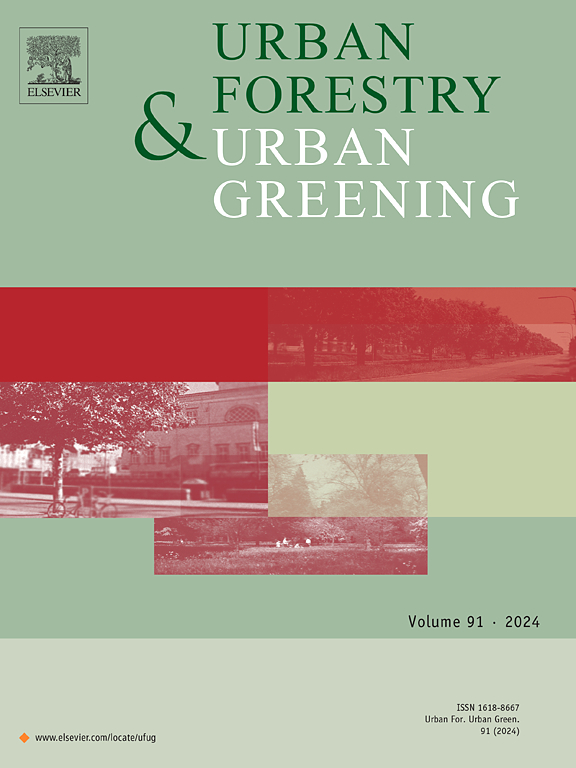Significant carbon storage and sequestration by urban greenery in Beijing city during 2010–2020
IF 6
2区 环境科学与生态学
Q1 ENVIRONMENTAL STUDIES
引用次数: 0
Abstract
As global urbanization continues, it has become increasingly important to understand the role of urban greenery in carbon (C) storage and sequestration for sustainable urban planning. However, due to a lack of long term field-based studies, the dynamic characteristics of C storage and sequestration by urban greenery over multiple years remain poorly understood. Here we developed specific allometric equations for various types of urban vegetation, and quantified the C storage and sequestration of urban greenery with different compositions of vegetation and landscape types across Beijing, from 2010 to 2020. This was based on field measurements from 604 sampling plots, combined with a dataset derived from the Urban Landscape Architecture Survey of Beijing. Our results showed that the biomass of urban vegetation (including various tree, shrub and bamboo species) could be well predicted using a combination of dendrometric variables, such as diameter at breast height (DBH), diameter at ground level (G), canopy width (W) or the height (H) of plants. Total (above- and below-ground) C storage by urban greenery increased from 2.6 Tg C (1 Tg = 1012 g) in 2010–6.3 Tg C in 2020, with the C sequestration of 0.32–0.43 Tg C yr−1. The C density of urban greenery varied from 4.1 to 6.9 kg C m−2 between 2010 and 2020, representing an annual C sequestration rate of 0.20–0.34 kg C m−2 yr−1. Combining this with a similar estimate for Beijing’s urban greenery in 2005 revealed that between 2005 and 2020, the C storage and density of urban greenery increased linearly over time. However, the C sequestration or annual C sequestration rate initially increased and then diminished over 2005–2020, which is likely linked to changes in vegetation physiology and plant age structure. These findings emphasize the need for effective management, such as planting optimal native vegetation types and species to maximize local adaptation and C uptake, as well as the expansion of urban vegetation, to enhance C storage and sequestration, thereby offering valuable insights for leveraging urban greenery strategies to mitigate climate change.
2010-2020年北京市城市绿化对碳的显著储存和固碳作用
随着全球城市化的继续,了解城市绿化在碳(C)储存和封存中的作用对可持续城市规划变得越来越重要。然而,由于缺乏长期的实地研究,对城市绿化多年来碳储存和封存的动态特征仍然知之甚少。在此基础上,建立了北京市不同类型城市植被的异速生长方程,定量分析了2010 - 2020年北京市不同植被组成和景观类型的城市绿化碳储量和固碳量。这是基于604个样地的实地测量,并结合来自北京城市景观调查的数据集。研究结果表明,城市植被(包括各种乔灌木和竹木)的生物量可以通过树木学变量如胸径(DBH)、地平面直径(G)、冠层宽度(W)或植物高度(H)的组合来预测。城市绿化的总(地上和地下)碳储量从2010年的2.6 Tg C (1 Tg = 1012g)增加到2020年的6.3 Tg C,碳固存量为0.32-0.43 Tg C /年。2010 - 2020年,城市绿化碳密度在4.1 ~ 6.9kgC - m-2之间变化,年碳固存率为0.20 ~ 0.34 kgc - m-2。结合2005年对北京城市绿化的类似估算,发现2005 - 2020年间,城市绿化的碳储量和密度随时间呈线性增加。然而,2005-2020年期间,碳固存或年碳固存率先增加后减少,这可能与植被生理和植物年龄结构的变化有关。这些发现强调了有效管理的必要性,例如种植最佳的原生植被类型和物种,以最大限度地提高当地适应和碳吸收,以及扩大城市植被,以增强碳的储存和封存,从而为利用城市绿化战略减缓气候变化提供了有价值的见解。
本文章由计算机程序翻译,如有差异,请以英文原文为准。
求助全文
约1分钟内获得全文
求助全文
来源期刊

Urban Forestry & Urban Greening
FORESTRY-
CiteScore
11.70
自引率
12.50%
发文量
289
审稿时长
70 days
期刊介绍:
Urban Forestry and Urban Greening is a refereed, international journal aimed at presenting high-quality research with urban and peri-urban woody and non-woody vegetation and its use, planning, design, establishment and management as its main topics. Urban Forestry and Urban Greening concentrates on all tree-dominated (as joint together in the urban forest) as well as other green resources in and around urban areas, such as woodlands, public and private urban parks and gardens, urban nature areas, street tree and square plantations, botanical gardens and cemeteries.
The journal welcomes basic and applied research papers, as well as review papers and short communications. Contributions should focus on one or more of the following aspects:
-Form and functions of urban forests and other vegetation, including aspects of urban ecology.
-Policy-making, planning and design related to urban forests and other vegetation.
-Selection and establishment of tree resources and other vegetation for urban environments.
-Management of urban forests and other vegetation.
Original contributions of a high academic standard are invited from a wide range of disciplines and fields, including forestry, biology, horticulture, arboriculture, landscape ecology, pathology, soil science, hydrology, landscape architecture, landscape planning, urban planning and design, economics, sociology, environmental psychology, public health, and education.
 求助内容:
求助内容: 应助结果提醒方式:
应助结果提醒方式:


